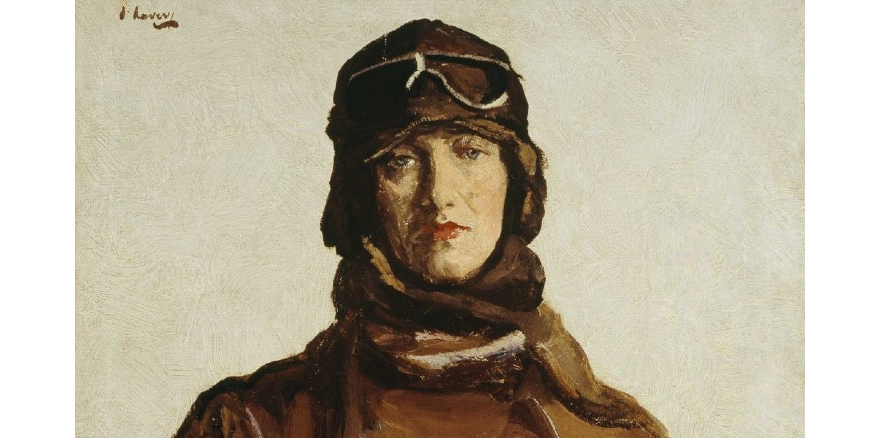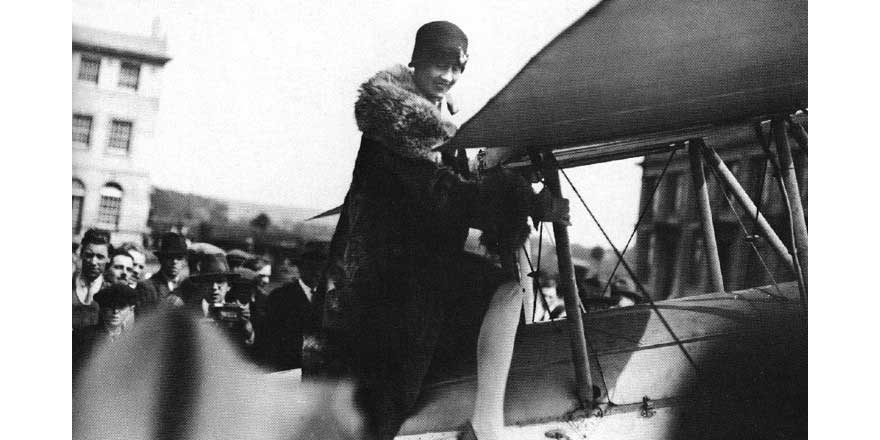
DIB Explorers: Lady Heath, aviator
14 July 2020With so many holiday plans on hold this summer, the DIB has compiled a selection of intrepid explorers we can accompany on their exciting travels. We start the series with Lady Heath, the first woman to complete a solo flight from South Africa to England.
Sophie Peirce-Evans (Lady Heath)
by Bridget Hourican
Evans, Sophie Catherine Peirce- (‘Elliott Lynn’; Lady Heath) (1896–1939), athlete and aviator, was born 17 November 1896 in Knockaderry, Co. Limerick, the only child of Jackie Peirce-Evans and his wife and former housekeeper, Kate Doolin (or Dowling) of Kerry. Jackie Peirce-Evans lived in Knockaderry House on 350 acres of land he had inherited from his maternal grandfather, Thomas D'Arcy Evans, and was known as an eccentric. His incessant pranks had led to his being fired in his youth from a position in the Provincial Bank, and in April 1895 he was ordered by the high court to pay his neighbour, William Power of Chesterfield, considerable damages for slander. Soon after Sophie's birth, Kate Peirce-Evans was found dead in Knockaderry House, with both husband and child gone. Jackie was charged with murder but was found insane and placed in a mental institution for the rest of his life. Sophie was reared by her grandfather, Dr George Peirce-Evans, and her aunts in Newcastle West, and educated in St Margaret's Hall School, Dublin. After the outbreak of the first world war she went to Britain and became a dispatch rider for a unit attached to the Royal Flying Corps from 1915 to 1918. She met and married in early 1920 an army officer, William Elliott-Lynn, and took a degree in agriculture in the early 1920s from the Dublin College of Science in preparation for farming with her husband in East Africa. Initially enchanted with life on the farm, she wrote a book of lyric poetry, East African nights (1925); however, after about eighteen months in Kenya her marriage broke up and she returned to England and began competing as an athlete.
Of amazonian proportions, she stood 6 ft (1.83 m) tall, weighed 11 stone (70 kg), and excelled in several events, notably the high jump and the javelin. She set a world high jump record of 4 ft 10.5 in. (1.49 m) at Brentwood, England, on 6 August 1923; and a world record of 173 ft 2 in. (52.78 m) for the Greek two-arm javelin throw at Stamford Bridge on 28 June 1924, a record that stood for fourteen months. As Elliott Lynn, she competed for Britain in two world games; at the 1923 Monte Carlo games she contested eight events: the 60 m, the 250 m, the 65 m hurdles, high jump (third place), long jump, shot, javelin (third place) and pentathlon (third place).
An evangelist for women's athletics, she helped set up the Women's Amateur Athletic Association (WAAA) in 1922 and was its chairwoman. The WAAA began with 25 members in one club; within three years it had risen to 25,000 members in 500 clubs. She also gave frequent BBC radio talks and published a coaching manual in 1925, entitled Athletics for women and girls, which gave comprehensive advice on basic training and was well ahead of its time. Her high profile led to her being asked by the International Athletics Federation to submit the case for women's inclusion in track and field to the international Olympic congress in Prague on 30 May 1925. Three years later, women were admitted to three athletic events in the Amsterdam games, where Sophie (now Lady Heath, after her marriage (12 October 1927) to an industrialist, Sir James Heath, following the death of her first husband) represented England as a judge.
By this stage she had received more notice as an aviator than an athlete. She was the first woman member of the London Light Aeroplane Club when it opened in 1925, and that year qualified for her private (‘A’) licence. Incensed by the International Commission for Air Navigation's ban on commercial licences for women, she bombarded the commission with statistics she had collected for the Olympic congress on women's fitness, and offered herself as a guinea pig for medical tests. The commission took up her offer and in January 1926 she began studying for her commercial (‘B’) licence, which she obtained three months later; in May 1926 the ban on women's licences was rescinded. Under a blaze of publicity, Elliott Lynn now began to set more records in her new profession: she was the first woman pilot to loop the loop, the first to make a parachute jump (April 1926), and she set an altitude record of 16,000 ft (4,876 m) in May 1927. On a unique one-day publicity raising tour of British aerodromes in July of the same year she covered 1,300 miles and touched down seventy-nine times in thirteen hours. Less than a week later she was in Ireland to promote interest in Irish flying clubs, and on 30 July she won the Grosvenor cup, the first time that an open race had been won by a woman. Her friend Mary Bailey was the only other woman present and came sixth. In September she began a tour of Scotland, where 10,000 turned out to see her in Aberdeen.
In February 1928 came the escapade that made her world-famous: the first solo flight by a woman from South Africa to England. Setting off from Pretoria on 17 February, she suffered sunstroke near Bulawayo, Southern Rhodesia (Zimbabwe), and had to make an emergency landing but recovered to arrive in Khartoum on 1 April. Refused an escort plane by the British air ministry, she cabled Mussolini, who sent a plane to meet her in Tripoli and escort her to Europe. From Rome she flew to London, finally landing in Croydon on 17 May where she stepped out of the machine wearing a silk dress, fur coat, and black straw hat, and proclaiming that ‘it is so safe that a woman can fly across Africa wearing a Parisian frock and keeping her nose powdered all the way’ (Daily Express, 17 May 1928). She had notched up another record, but the press, who christened her ‘Lady Hell-of-a-din’ disliked her forceful personality and self-promoting and did not give her full credit for her achievements. Honoured with a dinner from the African Society and lunch from the Overseas League, she made clear her imperialist leanings, expressing the hope that her flight would strengthen the ties between the dominions and Britain.

As a pilot with KLM, the Royal Dutch Airline, she regularly flew the London–Amsterdam route and from 1928 was frequently in America giving lectures and demonstrations. A severe crash in Cleveland, Ohio, in 1929 resulted in head injuries and steel plates had to be inserted in her skull. Though she recovered and flew again, she apparently suffered a personality change and became very eccentric. Her second marriage also ended in divorce in 1930 with Sir James commenting that his wife had flown away in the clouds, and her third marriage (November 1931) was to a black aviator, Reggie Williams. She returned to Ireland after her marriage and helped set up flying clubs, most significantly the National Irish Junior Aviation Club, inaugurated in May 1933. Her success in buying out Iona National Airways and Dublin Air Ferries was short-lived: it went bankrupt in 1935, whereupon she went to live in London. Her last years were scarred by instability, poverty, and alcoholism, and she died in 1939 after a fall from a London bus in May of that year. Her ashes were scattered by plane over Newcastle West. Eccentric to the last, she apparently arranged for them to fall at a precise time and over the exact place where the retired castle agent, Richbell Curling, liked to rest. She had long borne him a grudge.
Her death went unrecorded in the national press, though her achievements were arguably greater than those of the aviator Mary Bailey, who was created DBE in 1930. However, her exceptional achievements in women's athletics and aviation and her role in their promotion have been noted in the numerous recent books devoted to the subjects. A plaque has been erected on her former home, latterly the Allied Irish Bank, in Newcastle West, and she was commemorated by an Irish postage stamp in 1998.
Sources: Harald Penrose, British aviation: the adventuring years, 1920–29 (1973); Wendy Boase, The sky's the limit (1979); Michael Barry, Great aviation stories (1993), i; Newcastle West Historical Society, Annual Observer (June 1983), 62–7; Rosanne Welch, Encyclopedia of women in aviation and space (1998); Noel Henry, From Sophie to Sonia (1998); Stephanie Daniels and Anita Tedder, A proper spectacle: women Olympians, 1900–36 (2000); John Haughton, The silver lining (2003); ODNB
Image 1: Portrait of Lady Mary Heath by Sir John Lavery (1856–1941), oil on canvas, 1928.
Image 2: Lady Heath arriving at Croydon, UK, from Capetown, South Africa,1928 (http://www.ctie.monash.edu/hargrave/heath.html)



